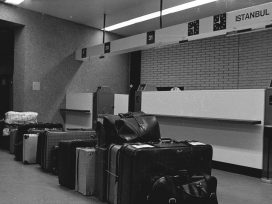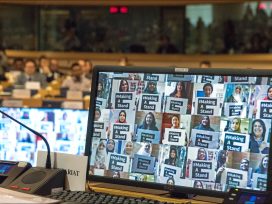Muslims in the West
Germany’s “Islam conference”, a two-part summit meeting between representatives of the Federal German State and Muslim organizations in Germany that took place in September 2006 and May 2007, was a serendipitous failure. What failed was the attempt to give Islam in Germany an official status, in other words, to give it the standing of a quasi-Church. An official Muslim body was to have been modelled on the Central Council of Jews in Germany (Zentralrat der Juden in Deutschland), which in turn was based on the example of the Christian Churches. In the case of the Central Council of Jews, doubts arose following Jewish immigration from Russia and eastern Europe whether its spokespeople were genuinely representative. Similar doubts were even more pronounced with the Muslims, who are more heterogeneous and without clerical organization. This diversity and lack of organization among Muslims cannot easily be overcome – neither from above, through the agency of the German state, nor from within; “contact people” with whom it is possible to discuss education, social questions, and not least security are still to emerge.
The experiment was a serendipitous failure, that is a partial success, precisely because Muslims do not have to speak with one voice and can no longer be characterized in monolithic friend-foe images (as in der Spiegel‘s “Mecca Germany” issue [13/2007], whose cover showed the Islamic crescent hanging over Brandenburg Gate). Now, the religious-theological, ideological-political, institutional-social, and ethnic-national diversity of the Muslim faith is visible. More important still, the lively debate among Muslims has frustrated forceful appropriation by the reactionary forces of conservatism, Turkish nationalism, and male chauvinism. These forces should not be allowed to direct the public legal bodies that the German state and organized Muslims hope to create so that Islam in Germany may be granted a long overdue status of legal equality. Moreover, foreign organizations such as the Turkish state, Egyptian brotherhoods, and Saudi financiers must stand back if a European Islam is to take shape.
The first point of contention is how many Muslims actually live in Germany, or, more precisely, “who is a Muslim?” Answers come in three forms: a demographic statistic, an interpretation based on certain prerequisites, and a cultural hypothesis. The statistic counts all immigrants from Islamic societies as Muslims; when the growing number of naturalized and converted Germans is included, that is almost four million. Calculated thus, Islam will soon be the second largest religious community in Germany. These figures are convenient for the Islamic organizations: although, according to their selective interpretation of membership, they represent only 300-400 thousand individuals, they can claim to speak on behalf of millions. Increasingly, the Muslim associations’ self-arrogated entitlement to represent “the” Muslim community is being contested by celebrity and ordinary Muslims alike. Against the claim to sole representation, they propose a cultural hypothesis: whether or not one is a Muslim, they argue, can be determined neither by origin nor narrow-minded theology, but rather by each individual, for him- or herself. Only a minority of those who by virtue of their family and immigrant background feel themselves to be “cultural Muslims” actually belong to a mosque association or practice the famous “five pillars and six articles of faith” that the newly founded Coordinating Council of Muslims (Koordinierungsrat der Muslime, KRM) set – like a litany – as a condition of belonging.
This predominantly conservative body was formed from four umbrella organizations that also set the tone at the Islam conference. Their orientation can be outlined as follows: the strongest is Ditib, a branch of the Turkish ministry of religion, once a secular representative of Ankara whose theological and moral stance has since become rural and conservative. Ditib contains the largest number of imams, who until now have mostly possessed neither knowledge of the German language nor familiarity with contemporary German society. The Association of Islamic Cultural Centres (Verband der Islamischen Kulturzentren, VIKZ) brings together Muslims of Turkish provenance who have been subject to Kemalist repression and persecution. It is a product of the cultural associations founded by the first generation of “guest workers” in reaction to their lack of a political and religious mandate. The Islamic Council, another organization led by Turkish Muslims, is urban, modern, and an advocate of full naturalization in Germany. The loudest voice within it is the fundamentalist Milli Görus (which is under observation by the German constitutional authorities); the Islamic Council claims to be loyal to the German constitution and, thanks to its legal expertise, is the champion of religious teaching on Islam in state schools. Lastly, the Central Council of Muslims (Zentralrat der Muslime), whose name probably takes after its Jewish counterpart, is a multinational amalgam of Muslims of predominantly Arab background. It is a stubborn opponent of co-education and is accused of having adopted some of the positions of the Egyptian Muslim brotherhoods, despite wishing to represent “mainstream Islam”.
These main currents included neither the Alevi, a religious minority group that is well represented in Germany, nor Shiites or Ahmadiyya Muslims. The umbrella organizations also have no control over radical Islamism, which above all uses the Internet as a platform for jihadist propaganda. Opposing the predominance of strict religious groupings of various orientations, a “silent majority” is making itself heard. It has found prominent spokespeople who declare themselves to be occasional, ex-, and non-Muslims, and who challenge the conservative lobby. In them, secular forces have found a voice; they respect the independence of the worldly sphere and that of politics, not least in its creation of the conference on Islam itself, along with the media echo it created.
These secular Muslims are eyed suspiciously as “media celebrities”, yet they are able to name three important prerequisites for the entry and establishment of Islam in the West. The first is that anyone may leave Islam in the same way as with any other religious community – religious “clan liability”, whereby family members are punished for the actions of their relatives, is unacceptable. The essence of secularization (and, ultimately, the guarantee of religious autonomy) lies in the recognition of social and religious pluralism, which in practice also means negative religious freedom and individual religious choice. Religious communities that de jure or de facto deny their members this right are just as wretched as a faith that can only respond to criticism, even when this is blasphemous, with sentimentality and aggression, as was the case in the “cartoon controversy”. To put it bluntly: the test of the maturity of a multi-religious society is its ability to maintain its dignity when faced with doubt, criticism, and even insult.
Second, the repression of Muslim females, propagated or tolerated by conservative theologians, cannot be inferred from the Koran. Consequently, courts and lawmakers may not accept it as the basis for decision-making – the same goes for discrimination against homosexuals. The main difference between the West and Islamic societies is not to be found in the latter’s relationship to democracy and civil society, but rather in their obstinate homophobia and sexual discrimination, justified on the basis of the Koran. Unlike with other religious communities (against a similar level of resistance), it has not yet been possible to civilize a tradition derived from the mores of obscure, patriarchal, tribal societies. Only in the confusion of religious values with patriarchal power are indefensible practices such as forced marriage and honour killings possible.
Third, restrictions on human and civil rights in the family, at school, and in working life, which dominate the daily life of immigrant communities (the wearing of the veil, halal butchery, boycotting physical education and sex education), and which until now have been tolerated on grounds of religious freedom, can no longer be welcome. Western constitutions forbid the import of questionable elements of family and civil law from Turkish and Arabic societies. These imports often entail opposition to obligatory school attendance and the right to education. Conservative Muslims argue that such obligations restrict the leeway, obtained in the name of religious freedom, for what is effectively the exclusion of females and the general sanctioning of deviant behaviour.
Mixed governance: On the regulation of transnational religious conflicts
Nevertheless, the fact that the conservative Islamic lobby was able to play such a prominent role is connected to the home-grown problems of the law governing the relation of Church and State in Germany. This law was unprepared for the change in the religious landscape brought about by immigration; still based on the analogy with the special role of the Christian Churches, it is fixated on the notion of a central authority. This brings together two idiosyncrasies of the old Federal Republic: the anachronistic symbiosis of Church and State and the now problematic “neo-corporatist” method of resolving conflicts by means of organized interest groups. Those not willing to relativize the privileged status of the Christian Churches were forced to credit non-Christian religious communities against their will. If the Coordinating Council of Muslims is now pursuing the very “un-Islamic” programme of turning Islam into a quasi-church, it is only seizing the opportunity offered by the law. The German state was a midwife to organized Islam, which it built into a neo-corporate framework based on the model of wage negotiations or the dialogue on the use of nuclear energy. This framework is now employed in state-supported, inter-religious dialogue and even as an instrument of mediation between differences within the Muslim community itself.
The conservative umbrella organizations have understood the corporate State very well and are now “Germanizing” themselves. However, the dissent from secular Muslims has shown that the organizations do not exert sufficient influence over those they claim to represent to be able act effectively as points of contact between Muslims and the State. Integration and the achievement of equality for Islam must take place on a broader and more pluralist basis. The more diversity Islam exhibits in public the better. One will have to get used to Muslims appearing on the public stage – visible, vociferous, and political. Those who want to give equal rights to non-Christian religious communities must undertake a careful revision of the relationship between Church and politics in Germany and get rid of the “religious-Christian bias towards the large Churches” (Ulrich Willems). Globalization is already making a contribution by stirring up the religious climate. Belief and believers have never stopped at barriers or language borders, but organized religions have successfully “nationalized” themselves: this territorialization of confession was bound up with the early modern formula of sovereignty, which after the treaties of Augsburg and Westphalia remained a determining factor well into the twentieth century.
In the meantime, however, we have entered the “post-Westphalian era” of the globalized religious market. The global market has perforated all territorial borders; migrants with religious baggage have created diaspora communities, which in the case of Islam are increasingly seeing themselves as parts of a borderless ‘umma and developing loyalties that belong neither to a particular country of origin nor to an ultramontane Church. This religious transnationalization is particularly serious for Europe because, despite the formal separation of politics and religion, national Churches have survived and are now coming under tremendous pressure. Religion and (national) culture have not only become uncoupled in the case of Islam: Protestant sects in particular also clearly demonstrate a global character that is not bound to ethnic-national origins.
Why is everyone talking about the “return of the religion” when simultaneously there are complaints about empty churches and a shortage of priests? Clearly, secularization and de-secularization are progressing side by side. In order to understand this, one has to differentiate between three aspects and two routes of secularization: the European route has only separated Church and State (even in secularist France) in a half-hearted manner: Christian religious communities have retained their monopoly on religious assembly and mobilization, the conclusion of which is the comprehensive privatization of religion and the extensive de-Christianization of Europe – a fact that is only apparently paradoxical.
In America, the picture is very different: there, the dividing line between religion and politics is clearer, but religiosity has remained in the public sphere and works as a “civic religion”, with the variety of denominations growing as fast as the number of believers. Here the result can also be seen: American religious diversity has survived numerous waves of doubt and still permeates public life and shapes accepted morality – and this without “state dosh”.
Muslims in the US have, all things considered, assimilated better than in Europe. This is not only because they generally enjoy a better social position. Rather, like earlier religious imports before them, they have entered the “religious supermarket” (Ruthven) and have “Americanized” themselves therein. Instead of forming an organized, hierarchical ecclesiastical structure, the route offered by German law, they have adapted themselves to the horizontal, egalitarian structure of sects in America and to the lively, and for Europeans confusing, religious landscape embedded in local communities.
This pattern of integration seems to be spreading throughout the world, such that it is western and central Europe whose religious development is the exception that many sociologists of religion, following Max Weber, believed America to be. If religious globalization means “Americanization”, then this has the following consequences for the religious landscape of Europe:
(a) a strict division of Church and State combined with the open presence of many religions in the public sphere;
(b) the erosion of religious oligopoly in favour of a horizontal and dispersed structure of religious communities whose coexistence resembles more that between sects than between Churches;
(c) more popular religiosity and more intensive practice of religion;
(d) parallel subjectification and individualization of the practice of religion; and
(e) opportunities for politicized religious lobbies in domestic and foreign policy.
Today, religion is woven into both national and international conflicts. America, Europe, and the rest of the world differ in the way such conflicts are resolved, be it politically, community-oriented, or market-based. The method used depends on the different paths of historical development: in Europe, the experience of bloody religious wars between rival faith communities with exclusives claim to truth led to the recognition of the sole authority of a political power, in other words the State as constitutional body possessing a monopoly of force within a certain territory.
In contrast, in the “stateless society” across the Atlantic, the experience of religious intolerance and multi-religious immigration has fostered greater trust in the peaceful competition of different sects. Peace is not guaranteed by the Hobbesian state, but rather by the market and the interests of individuals, who group together in local communities and cultivate their religious identity. In the US, the creation of communities based on religion accommodated to a structure of religion that early on was attuned to the market: sects cannot take their believers for granted, but have to win them over. Believers are addressed as autonomous individuals with their own interests, who decide their confession on the basis of conscience. Moreover, where believers are treated as consumers, missionary work is free of obligation. Uncomplicated, even multiple conversions and a blossoming hotchpotch of ready-made religious elements belong to this open religiosity.
Alongside the esoteric spiritual current, the Evangelical Free Churches and the Pentecostal movements are the most prosperous on the global religious market: they have overtaken mainstream Protestantism in the US and are spreading in Catholic Latin America, in West Africa as a competitor to Islam, in “heathen” post-Soviet eastern Europe, and throughout Asia. The astonishing success of the Pentecostals in reaching out to new believers is a product of their ability to switch religious practice from “cold” to “hot”: the experience of religion is placed above doctrine, movement is preferred to hierarchy, and emotion is more important than reason. Because miracles trump science, even creationism and the teaching of “intelligent design” are finding supporters in Europe. Even the most stable Church hierarchy has not failed to notice the introduction of informal modes of belief (“believing without belonging”): the Vatican, like all mass organizations, is being confronted with the momentum of episodic movements and decentralized networks and is being forced to adapt.
Neo-fundamentalist Islam fits surprisingly well into this picture of an “Americanized” religious landscape. It is also trans-national in that it has liberated itself from the core Arabic-Islamic countries and has cast off its diaspora identity. It appears individualistic in that it contests the authority of conservative theologians and legal scholars, placing religious experience above orthodoxy. Here too, religiosity is born again: it displays the strong conviction of people who have found again their lost faith in an existential crisis and who from then on lead their lives in the affirmation of this rebirth.
This Islamic neo-fundamentalism also expounds religion as an individual experience and a radical break with tradition. This makes it attractive for marginalized third-generation immigrants in the suburbs, who join a (not simply imagined) global community of militant Islam. Symbols (the headscarf), symbolic presence (Mosques), and orthodox practices (halal) are important in order to profess belonging to this community – as is, increasingly, the propaganda of the deed.
This is not “stone-age” Islam. The return of puritanical religiosity is far more an alternative pathway to modernization. For Islam it is tantamount to Westernization, even when it so vehemently rejects the Western consumer culture in which young Muslims are immersed – as deviant drug dealers as much as exemplary IT students. Or as shipbuilders in Bremen: the life of the German born Turkish citizen Murad Kurnaz may seem peculiar, but it is just as rational and logical as a conversion to al-Qaeda out of protest. Both can be better understood – especially in the sense of anti-western western Islam’s “observation of the adversary” (Gegnerbeobachtung – Lepenies) – if one comprehends them as neo-religious acts. Neither political entrepreneurs and pseudo-churches nor Muslim communities will be able to civilize them with ease – but nor will State surveillance and repression. A period of “mixed governance”, meaning here a complex religious regime that goes beyond the state and market, has commenced.





